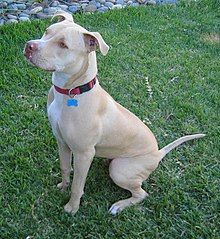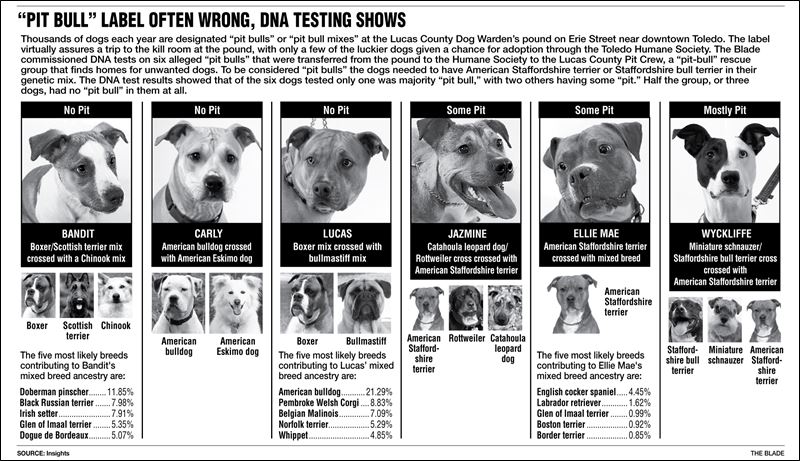What's On This Page?
•
National Pit Bull Awareness Day
•
Introduction
•
The Pit Bull
•
Media and Pit Bulls
•
Pits and Other Bully Breeds
•
The Pit Bull in Family Homes
•
Disproving the Myths About Pit Bulls
•
Breed-Specific Legislation (BSL) and Pit Bulls
National Pit Bull Awareness Day
is October 27th.
Introduction
Pits4PEACE was started on June 23, 2013, with the
dream of equality for all dogs. National Pit Bull Awareness Day is October 27 (read more).
As many people know, Pit Bulls and other bully
breeds (bulldogs, dogo argentinos, staffordshires, and the like), have been
gaining an unearned bad reputation for the past 50 years. But they weren't
always known as that. For hundreds of years before, Pit Bulls were known for
their strength, agility, and family loyalty. In fact, they were known as
"the nursemaid's dog", because of their kindness and protective
attitude towards children.
But when Pit Bull attacks started to become more
frequent, most of the time on the part of careless owners, the media began to
give them a horrible reputation.
The dog we know as "the pit bull" is one
of hundreds of dogs classified as a "bully breed". When we think of
pits, we think: stocky, pointy ears, short, HUGE jaws. But the pit
is part of a group of dogs called bully breeds, which includes many
other dogs, such as Staffordshire Terriers and
those lovable skateboarding bulldogs.
In fact, the actual dog, the pit bull, is officially called the "American Pit Bull Terrier".
However, Pits4PEACE is dedicated to helping all bully breed aka "pit bull" dogs.
In fact, the actual dog, the pit bull, is officially called the "American Pit Bull Terrier".
However, Pits4PEACE is dedicated to helping all bully breed aka "pit bull" dogs.
Media and Pit Bulls
You would never have thought a dog could have so
many different expressions. If you looked at pictures of them side by side, it
could’ve been many different dogs, all different in temperament from one
another: this one’s curious, she’s shy, a big chewer of bones, or a needy
princess in disguise.
That in itself is the nature of the American Pit
Bull Terrier (yes, and now you’ve learned the first thing about Pit Bulls—the
name is actually two separate words!) Granted with almost human-like eyes, Pit
Bulls can show very different emotions just with their facial expressions. A
crinkled forehead and downcast eyes mean, to us, a curious puppy. A panting dog
with blunt features implies an uncaring pound creature. And the pound dog is
what many people have started to see in Pit Bulls over the past few years—and
just from the media.
But the media is wrong—as they have been proven
time and time again over the ages.
In fact, after a few well-publicized
Pit Bull attacks, the media began publishing any attack by a dog on a person as
a “Pit Bull”—even if they were actually Staffordshire Terriers, a close
relative of the Pit Bull, or just mixes. In reality, there are as many bites
from other breeds as there are from Pits—they just don’t make a big enough
“splash” to get reported.
Staffordshires
look very similar to Pit Bulls upon first glance—the boxlike head and those
special ears—but really, they are very different.
Staffordshires, just like Pits, were bred to be
fighting dogs. They would fight with Bulls just for people’s entertainment,
often to the death. As of now, though, dog fighting has been banned in the
United States, though it is still popular in many parts of the world. But
whereas the modern-day Pit’s temperament is affectionate, clownish,
intelligent, and friendly, the Staffordshire is a much more outside-the-home
dog: it is bold, fearless, reliable, and courageous, while still being
intelligent, loyal, and affectionate. This isn’t saying that Staffordshires are
worse than Pit Bulls, because they aren’t. Their blame just shouldn’t be
pressed in on the Pit Bulls. (In fact, you'll find Staffordshires need just as
much advocacy as Pits do, in the long run!)
Other bully breeds (the group which pits are grouped
in) include all types of bulldogs, dogo argentinos, boxers, Boston terriers,
bull terriers, bullmastiffs, American Staffordshire terriers, and staffordshire
bull terriers.
Pit Bull
Terriers have long lived as family house pets: the handlers would often keep
the Pits in their own homes during the fighting dog days, where they were so
gentle and sweet to the children, they earned the nickname “nursemaid’s dog”.
For many years after those days passed, despite their bloody history, the Pit
Bull’s reputation was a good one, full of honor, companionship, and
glory.
During World War One, they were often a symbol of the United
States for their courage, loyalty, and bravery. One dog, a Pit by the name of
Stubby, earned several medals during WWI for warning soldiers of gas attacks
and finding dead or injured soldiers. They were also often used in advertising;
Wells Fargo Banking and Levi’s jeans, to give out a few name brands.
Disproving the Myths About Pits
Nowadays,
people who want to appear “tough” often go out and buy Pit Bulls. This in
itself isn’t too bad—but then they teach them to behave aggressively towards
people and animals…which eventually leads to their bad reputation. In truth,
pits ranked in the 90th percentile in a behavioral study with dogs, ranking
them along beagles, a common family dog that has enjoyed the limelight of
popularity for the past 50 years or so.
And, contrary to popular belief, pits DO
NOT have "locking jaws"; in fact, they were originally bred to catch
and HOLD hunted animals WITHOUT KILLING THEM, so if their jaws locked, they
couldn't have managed it. It was only later that they became popular dogfighting
dogs.
Nor are they vicious dogs that eventually turn on
their owners--as was mentioned before, they ranked in the 90TH PERCENTILE,
which is amazingly high (in the top 90%!). They're also SAFE AROUND CHILDREN,
and often are nanny-like (just like Nanna, a sheepdog in the animated Disney
movie "Peter Pan").
And YES, OF COURSE pits chase cats! EVERY DOG BREED
chases cats, squirrels, and birds, with rare exceptions of a few dogs!!!
Unfortunately, due to BSL, or Breed-Specific
Legislation, pit bulls are not allowed in some cities, states, and even
countries.
Breed-Specific Legislation, more commonly known by
its abbreviation/acronym, BSL, is common among the pit bull breed. BSL is when
a specific breed of animal (such as dog) is banned or must be "controlled
properly" in certain areas. Places with BSL either do not allow pit bulls
AT ALL in the state or enforce rules that require pit bulls to wear muzzles or
chain collars in public places and perhaps even in homes. U.S. States that constitutionally
uphold BSL laws against Pit Bulls are: Arkansas, Colorado, Florida, Iowa,
Kansas, Kentucky, New Mexico, Ohio, Utah, Washington state, West Virginia,
Wisconsin, and--here comes the big one--Washington D.C., our nation's capital.
And that's not even counting the thousands of cities or countries worldwide!
Help support Pit Bulls. Join Our Team.





No comments:
Post a Comment